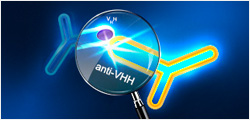| Species |
Human |
| Protein Construction |
BAFF (Ala134-Leu285)
Accession # Q9Y275 |
|
| Purity |
> 95% as analyzed by SDS-PAGE
> 95% as analyzed by HPLC |
| Endotoxin Level |
< 0.2 EU/μg of protein by gel clotting method |
| Biological Activity |
ED50 < 20.0 ng/ml, determined by dose-dependent mitogenic activity on human RPMI 8226 cells, corresponding to a specific activity of > 5.0 x 104 units/mg. |
| Expression System |
CHO |
| Apparent Molecular Weight |
~17 kDa, on SDS-PAGE under non-reducing conditions. |
| Formulation |
Lyophilized after extensive dialysis against PBS. |
| Reconstitution |
It is recommended that this vial be briefly centrifuged prior to opening to bring the contents to the bottom. Reconstitute the lyophilized powder in ddH₂O or PBS up to 100 μg/ml. |
| Storage & Stability |
Upon receiving, this product remains stable for up to 6 months at lower than -70°C. Upon reconstitution, the product should be stable for up to 1 week at 4°C or up to 3 months at -20°C. For long term storage it is recommended that a carrier protein (example 0.1% BSA) be added. Avoid repeated freeze-thaw cycles. |

ED₅₀< 20 ng/ml, determined by dose-dependent mitogenic activity on human RPMI 8226 cells, corresponding to a specific activity of >5.0 x 10⁴units/mg.
| Target Background |
B-cell activating factor, also known as BAFF, TALL-1, TNAK, and zTNF4, is a member of theTNF ligand superfamily designated TNFSF13B. Produced by macrophages, dendritic cells, and T lymphocytes, BAFF promotes the survival of B cells and is essential for B cell maturation. BAFF binds to three TNF receptor superfamily members: B-cell maturation antigen (BCMA/TNFRSF17), transmembrane activator and calcium-modulator and cyclophilin ligand interactor (TACI/TNFRSF13B) and BAFF receptor (BAFF R/BR3/TNFRSF 13C). These receptors are type III transmembrane proteins lacking a signal peptide. Whereas TACI and BCMA bind BAFF and another TNF superfamily ligand, APRIL(a proliferation-inducing ligand), BAFF R selectively binds BAFF. The BAFF R extracellular domain lacks the TNF receptor canonical cysteine-rich domain (CRD) and contains only a partial CRD with four cysteine residues. Human and mouse BAFF R share 56% aa sequence identity. BAFF R is highly expressed in spleen, lymph node and resting B cells. It is also expressed at lower levels in activated B cell, resting CD4+ T cells, thymus and peripheral blood leukocytes. |
| Synonyms |
BLYS; CD257; TALL1; THANK; ZTNF4; TALL-1; TNFSF20; TNFSF13B; B-cell Activating Factor |
For laboratory ����research use only. Direct human use, including taking orally and injection a������nd clinical use are forbidden.


































